The cool wet weather in the Pacific Northwest this year has delayed snowmelt in the alpine areas. There is so much snow in the North Cascades that the road to Artist's Point near Mount Baker will not be cleared this year. Last weekend we headed down to the Wenatcheee Mountains on the east side of the Cascades hoping to find snow-free alpine areas. We were not disappointed.
The Claytonia megarhiza v nivalis was spectacular on the summit ridge of Iron Peak and there were even a few Douglasia nivalis still in flower. The Claytonia and Douglasia were dotted around the serpentine scree together with Anenome drummondii , Castilleja elmeri and Ivesia tweedyi. We were fortunate to meet Richard Ramsden on the trail who pointed out some of the other Wenatchee endemics such as Lomatium cuspidatum.
Comments
Re: Wenatchee Mountains
David super pictures,as you know we were there last year and it brings back great memories. It is a wonderful area
Re: Wenatchee Mountains
Wonderful pictures, David. Did you find a range of color forms in the L. tweedyi? One you photographed looked almost yellow. That was one of the color forms exhibited at the plant show at the Nottingham Conference this year.
Re: Wenatchee Mountains
Wow, terrific collection of plants! The scenery and soil colour look so different from what we see around here. The claytonia and lewisias are just amazing.
The penstemon looks very unusual for P. procerus... the rounded leaf shape, prominent teeth and long basal petioles seem odd for that species. Any chance it might be P. pruinosus?
Thanks for posting those shots - it's wonderful to get the opportunity to see that area!
Re: Wenatchee Mountains
Anne:
Most of the Lewisia tweedyi in the wild look yellow to me, some more creamy than others. The ones with orange or peachy tones are much less common. We have one very small disjunct population of Lewisia tweedyi in Manning Park, BC. They are all yellow with no orange tones.
Re: Wenatchee Mountains
Lori:
I think you are right. It is Penstemon pruinosus. I didn't look too closely at the penstemon and assumed it was procerus which is quite common in the Cascades. The Washington Native Plant Society plant list for Tronsen Ridge confirms your observation:
http://www.wnps.org/plant_lists/counties/chelan/documents/TronsonRidge2f...
The entire hike up Iron Peak is on serpentine rock and soil which gives a strange appearance to the vegetation. There are areas with no trees at quite a low elevation and Douglasia nivalis grows in those open areas as well as on the ridge. The summit ridge of Iron Peak is all rusty brown rock and scree dotted with an amazing collection of plants unlike anywhere I have ever seen.
Re: Wenatchee Mountains
Here's the Penstemon pruinosus which shows the upper part of Tronsen Ridge in the background. Plus a couple more of the Claytonia megarhiza v nivalis from Iron Peak.
Re: Wenatchee Mountains
superb, David!
How much does a plant of Clematis columbiana spread there?
Re: Wenatchee Mountains
Rick:
Most of the Clematis columbiana on Tronsen Ridge are quite straggly as you would expect. The clump in the photo was quite unusual and was about three feet across. Clematis columbiana v tenuiloba forms beautiful small clumps but we have only seen that form in Utah and the Bighorns.
Re: Wenatchee Mountains
Fantastic pictures of beautiful plants! What a place to hike ;)
Re: Wenatchee Mountains
Superb images David ... many thanks for posting. Another mountain range we MUST visit!
Re: Wenatchee Mountains
Lori:
The entire hike up Iron Peak is on serpentine rock and soil which gives a strange appearance to the vegetation. There are areas with no trees at quite a low elevation and Douglasia nivalis grows in those open areas as well as on the ridge. The summit ridge of Iron Peak is all rusty brown rock and scree dotted with an amazing collection of plants unlike anywhere I have ever seen.
David, that might be a clue why Douglasia nivalis doesn't stay with me for more than a couple of years. It must need something in the soil it's not getting. It's such a lovely plant and blooms so early.
Re: Wenatchee Mountains
Anne:
Douglasia nivalis also grows on Tronsen Ridge (sandstone) and Chumstick Mountain which doesn't appear to be serpentine. I suspect that it grows on Iron Peak because it can tolerate the serpentine and the serpentine eliminates most of the competition.
I too have tried Douglsis nivalis in the garden but lost it quite quickly. It grows OK in a clay pot in a plunge bed in the Alpine Shed. I am currently trying it in a sand bed among tufa blocks. That may sound strange as it is obviously not a calcicole but it seems lots of plants like tufa so it is an experiment.
Re: Wenatchee Mountains
Talking of Chumstick Mountain we also drove up to the top of this wonderful natural rock garden located northeast of Leavenworth. The huge beds of Douglasia nivalis had finished flowering and it was a bit too early for seed but there were lots of other plants still in flower. Two outstanding plants were Calochortus lyallii and Lilium columbianum.
Re: Wenatchee Mountains
I think some of the plants that grow so well with tufa may simply like the better supply of moisture and can be tolerant of lime. It's amazing the wide range of plants that seem to grow well near or in tufa.
Re: Wenatchee Mountains
Wonderful topic; I've wanted to respond but have been way too busy. David, wonderful photos of great plants!
When I lived in the Seattle Washington area from 1982-86, my favorite botanizing haunts included the Wenatchee Mts... the memory stream back when I see these images in this thread. I have often wondered why only the typical apricot-pinkish form of Lewisia tweedyi was in cultivation, when there are some incredible yellow forms and yellow-strongly-tinged-red forms. For some reason two plants always come to mind when I think of the Wenatchees; Penstemon gairdneri, like small bonsai shrubs in two color forms; an intense purplish form, but it was the clear deep blues that I liked best, and Eriogonum douglasii (in a narrow rolled-leaf form that corresponds to the entity "var. tenue") that came in every color from cream to incredible candy pinks to raspberry reds among dwarf mats of ash-silver foliage.
Re: Wenatchee Mountains
Wonderful pictures again! I particularly liked the Lomatium!!
Re: Wenatchee Mountains
David, I loved your report and photos from the Wenatchee Mountains - have tried to grow Douglasias and Claytonias here without luck (if you can't grow them out there near their native habitat, I probably don't have a hope of success out here with them). I did have some success with a Calochortus bulb one time - planted it VERY deep on a south facing slope and it did well for a couple of years and then just disppeared. Would very much like to have more of them but have steered clear of ordering seeds from the Seedex as they take such a long time to reach flowering stage (as do all lilies in my experience) and, at my age, there just isn't enough time for the 'slow pokes'. Fran
Frances Howey
London, Ontario, Canada
Zone 5b
Re: Wenatchee Mountains
Following this with great interest. Would I be wasting my time trying some Douglasia and Claytonia outside here in my wet(very) Zone 9b and would they take to pot cultivation under glass?
Re: Wenatchee Mountains
Following this with great interest. Would I be wasting my time trying some Douglasia and Claytonia outside here in my wet(very) Zone 9b and would they take to pot cultivation under glass?
David/Fran:
I have had Douglasia laevigata growing outside for about 8 years. The flowering is not spectacular though - nothing like in the wild. I tried Claytonia megarhiza outside and Douglasia nivalis but they soon packed it in. I am now trying Douglasia nivalis in a sunnier spot in the garden among bits of tufa. So far it looks good but they have to survive a wet winter yet.
Pot cultivation under glass is definitely easier. I have had Claytonia megarhiza v nivalis for several years in the plunge bed in my Alpine Shed and have had good flowers. Douglasia nivalis is also quite easy in a pot. This one was from seed from Chumstick Mountain a couple of years ago and it flowered beautifully last Spring.
Re: Wenatchee Mountains
Thanks David, i'll be looking out for both.
Re: Wenatchee Mountains
Hi David,
Claytonia megarhiza v. nivalis grows and flowers well in a medium sized pot here in Lancashire. It stays outside (i.e. no cover whatsoever) from the end of April until October and then in an open-sided frame throughout the winter. It is in a very gritty compost with pebbles incorporated into the mix. It has self-seeded into adjoining pots, but these seedlings don't transplant very easily. I might be tempted to sow some of your seed onto a large pot capable of supporting these deep rooted plants for their lifetime.
Re: Wenatchee Mountains
Hi Cliff,
Many thanks for that. Does it mind lime please?
Re: Wenatchee Mountains
David:
My potting mix for pots in the Alpine Shed is mostly coarse sand with about 15 -25% crusher fines and a little bit of pH corrected peat. We can't get John Innes composts here so we have to make it up as we go along. The crusher fines have lots of mineral nutrients which I think is a real bonus. Because I have no soil at all in the mix I occasionally add a bit of fertilizer.
My experiment with a sunny sand bed with lumps of tufa and sub-irrigation is working well. The Douglasia nivalis survived the soggy, wet winter and produced quite a few flowers (see below). I planted Claytonia megarhiza v nivalis last spring in a similar location and it is doing fine but has not yet been though a winter. Both plants grow in serpentine areas in the Wenatchee Mountains so are pretty tough. There is no limestone anywhere near where they grow but they don't seem to mind growing among lumps of tufa. There may not be much or any lime released by the tufa though.
Re: Wenatchee Mountains
That is a very interesting growing regime David and it appears to be working well. I suspect that the Claytonia will tolerate (but certainly not require) a modicum of lime. I don't purposely introduce lime, but there may be a little released by the mixed pebbles that I include. Be wary of pampering them too much Mr. N. ... like a great many alpines they repay neglect and disdain, well they do in my garden anyway! :D
Re: Wenatchee Mountains
Lori:
I have certainly found Douglasia nivalis easier to grow than Douglasia montana. Mind you the Douglasia montana I have had were purchased plants and it may do better from a seed grown plant (or at least you have more plants so you can accept a few losses :D ) Most Androsaces seem to come easily from seed and Douglasia nivalis is no exception. I have attempted to grow Douglasia montana with seed from the Androsace Group of the AGS. They grew very well but turned out to be a hybrid of Androsace carnea :-\ .
Wild seed of Douglasia nivalis is currently available through the Alpine Garden Club of British Columbia Seed Exchange.
Re: Wenatchee Mountains
Just found this thread- great place and plants, David!
Re: Wenatchee Mountains
David and Cliff many thanks. If they do well on neglect and disdain Cliff they'll get both in spades in my garden!

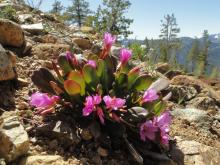
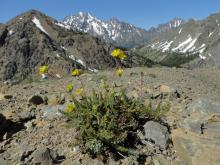
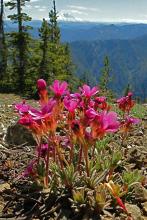
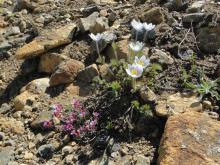



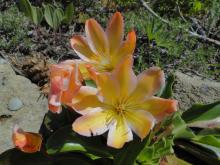
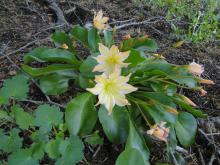
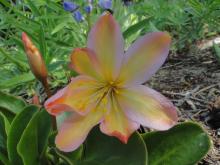
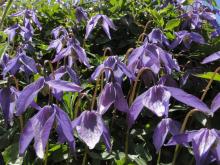
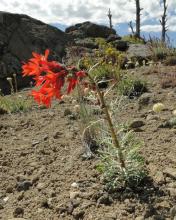
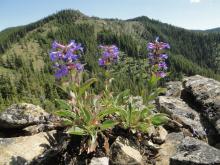
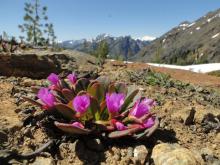
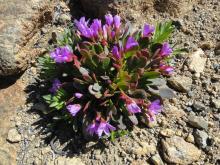
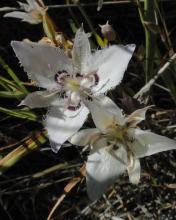
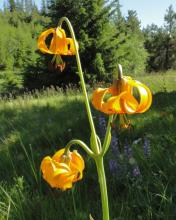
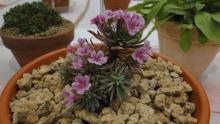
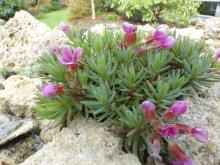
On Sunday July 24 we went up Tronsen Ridge. At the lower elevations the Lewisia tweedyi had finished flowering but Lewisia rediviva was emerging. There were lots of Penstemon particularly Penstemon pruinosus and some nice clumps of Clematis columbiana. Near the summit of the ridge there was a wonderful rock garden with different colour forms of Lewisia tweedyi in full flower which we had not expected so late in the year. On top there were some lovely dwarf forms of Ipomopsis aggregata and many species of Eriogonum.